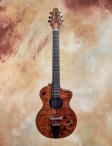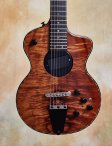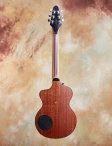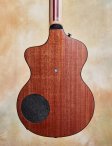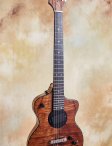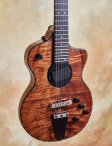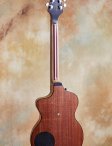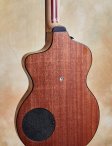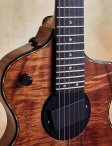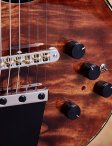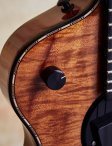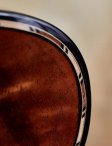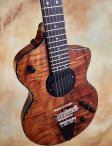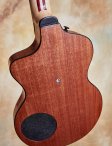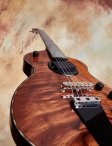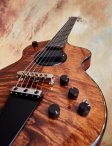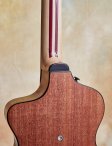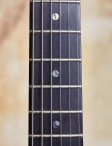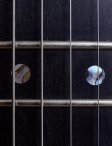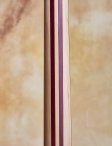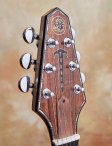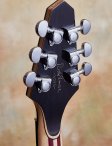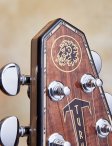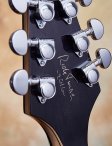Rick Turner Model One Koa Top

Price: $--SOLD
inquire - info@crguitars.com
call us -
hardshell case included
Apart from the very cool and highly individual aesthetics of the instrument, what is especially unique and spectacular about the Model One is that it has the sonic flexibility to allow any player to get their own sound. You'll be simply amazed at the flexibility of the relatively simple controls. The guitar is very well balanced, articulate and has a vocal quality that is dynamically responsive.
When you consider guitars in the 21st century, most of the examples out there have the DNA of a small handful of designs. I should mention that I don’t mean this as a criticism in the least, and in fact most of the instruments that we bring into CR Guitars are a reflection of this fact. I also made my living for many years playing very traditional guitars whose heritage goes straight back to Fullerton and Kalamazoo.
The fact is that Gibson and Fender got things right with their designs, and those of us who are deeply connected to the electric guitar can’t avoid the defining characteristics of those iconic instruments. But Fullerton and Kalamazoo are not the whole story.
Like any other endeavor, there are iconoclasts, guitar builders who have a strong individual compass, a desire to create something that asks a different set of questions. I am always excited to find such builders, especially when their instruments fulfill the mission of CR Guitars. Namely, to find guitars built by a passionate and devoted luthier, made with impeccable craft, masterful wood selection, and thoughtful design details; that possess a strong, articulate and resonant voice, fantastic balance across the fretboard; and most of all made with love. I look for great guitars for CR, both traditional and innovative.
Rick Turner is just such a luthier, and his Model One is just such a guitar.
Rick started his career winding pickups by hand, but with far fewer windings than traditional pickups (he learned to stop the windings when his hand cramped too much). His pickups didn’t have the signal strength of others because the impedance was much lower, but they had a wider dynamic range. Working with Ron Wickersham, Turner developed active electronics for guitars and basses, and in 1970 became a partner in the newly created Alembic company in Novato, CA.
Turner honed his instrument making skills over the next eight years at Alembic, building guitars and basses for some of the most famous bands of the time, including The Grateful Dead, Crosby, Stills, Nash & Young, Jefferson Airplane, Led Zeppelin, The Who, The Allman Brothers Band, and countless others.
In 1978 he left Alembic to focus his considerable skills on his own guitar, the Model One. From the start the design was unique, with a laminated neck, cylindrical arched top, and the active electronics he developed at Alembic. After prototyping, the first production guitar went right into the hands of Fleetwood Mac’s Lindsey Buckingham, who has played the model as his main guitar ever since.
Apart from the very cool and highly individual aesthetics of the instrument, what is especially unique and spectacular about the Model One is that it has the sonic flexibility to allow any player to get their own sound. I am simply amazed at the flexibility of the relatively simple controls. The guitar is very well balanced, articulate and has a vocal quality that is dynamically responsive, with an incredible range of nuances. Spending just a little time getting to know the EQ and controls allows you to zero in on the tone you want. This is a perfect guitar for someone who has a sound in their head that they want to achieve.
Rick’s website has a great description of his controls, and it is worth quoting it here:
"First, switch the EQ out. Then adjust the tone control all the way up and then blend back and forth between the magnetic and piezo pickups. This is very different from the usual Les Paul or Strat pickup selection, and acts more like a zoom lens on a camera ranging from the more mid focused sound of the magnetic pickup to the more acoustic and wide range piezo pickup, which actually has more deep lows as well as more extended highs. When you are in the "just magnetic pickup" position on the blend knob, try pulling up on the tone knob to access the single coil sound. That is a sound more akin to the middle pickup on a Strat.
"When you've learned your way around without the EQ, find a tone you like and then kick in the EQ with the Boost/Cut knob turned about 1/2 of the way up from the middle detent position. This would put the knob line at the 9:00 position relative to the detent being 6:00. Then sweep the middle frequency knob to hear how the boost affects tone at different registers. For the full out sound, crank the EQ boost all the way up and repeat the frequency sweep. If you are playing into a tube amp or distortion unit, you can use the EQ to voice overdrive harmonics. Lesser boost is great for finding nice tones into a clean amp as well. While most folks don't use the "Cut" feature of the EQ, that, too, has some very nice uses."
The model one has now been in production for 37 years, and it is fair to say a luthier of Turner’s passion and commitment has improved his skill over time. Because of its wonderfully articulate and resonant tone, and its very adaptable electronics, it is a guitar that you can genuinely use in any musical situation.
Starting with its stellar piezo system, the acoustic tone is marvelous, and led the storied acoustic luthier Jeff Traugott to opine “What is it with you Rick? Why do your guitars sound more acoustic than mine when mine is an acoustic guitar and yours isn’t?” Blend in the magnetic pickup for very convincing traditional archtop tones, or run the magnetic pickup into an overdriven amp for distortion heaven. You can cover rock, country, jazz, blues, even heavy metal with this guitar!
The top on this guitar is pretty special, not least because Turner has rarely used koa in the Model One. But it is also stunningly beautiful, and makes for a strong visual statement in a small-bodied guitar. The neck is comfortable and solid, and you can feel the vibrations of the strings throughout the instrument.
I really love the completely original look and vibe of this guitar, and deeply appreciate the versatility. Check out the great videos on YouTube with John Mayer and Lindsay Buckingham playing their Model Ones for a taste of this superb instrument.
If you'd like to find out more about this item, just call or e-mail me. It would be my pleasure to talk to you about it.
ABOUT RICK TURNER GUITARS
Rick Turner is the founder of the highly influential Alembic Guitars. Based on combining Rick's hand-wound low-wind low impedance pickups with active electronics, Alembic instruments have found their way into countless musician's hands. Rick eventually left Alembic to pursue the design of his own line of instruments, including the Model One guitar and has been dedicated to developing that line ever since. Rick's approach is different; his instruments are superbly rich in harmonics; his piezo electronics are ground breaking. Rick Turner may not be hand-winding his own pickups anymore, but he certainly hasn't stopped discovering ways to turn the music world on its head. His writing in American Lutherie, Guitar Player magazine and Acoustic Guitar serves to inspire young luthiers and remind the community of the importance of meticulous craftsmanship and top-quality materials. And innovation, an area in which Rick has always excelled.
| Top | premium highly figured flame koa w/fancy purfling |
| Body | select mahogany |
| Neck | 5 piece laminated mahogany and hard maple, set neck |
| Fretboard | rosewood |
| Nut width | 1 11/16" |
| Scale length | 24.75" |
| Radius | 12" |
| Neck profile | full C |
| Finish | natural |
| Pickups | Turner hot wound, hum-canceling with split coil, Piezo elements in each bridge post |
| Electronics | Piezo/magnetic blend, on board preamp, parametric EQ |
| Bridge | Gotoh with Turner in-house made tailpiece |
| Tuners | Gotoh |
| Weight | 7.9 lbs |
| Case | custom hard case |

